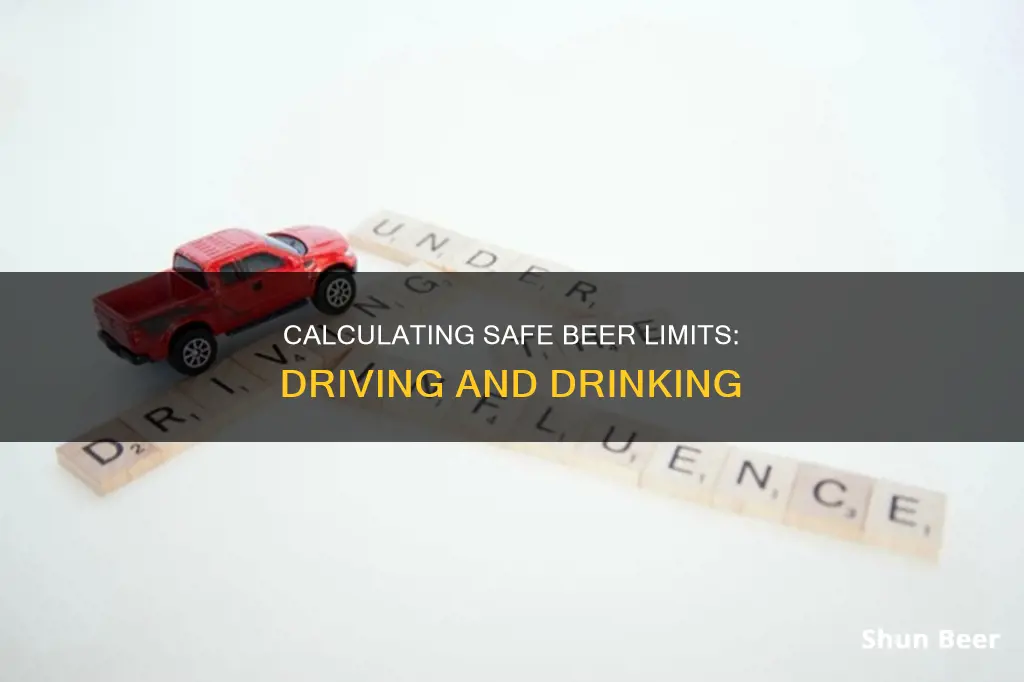
Drinking and driving is a serious issue that can lead to fatal consequences. Blood Alcohol Concentration (BAC) is a commonly used measure of alcohol intoxication, and it is typically expressed as a percentage of alcohol per volume of blood. The legal limit for BAC when driving in the US is 0.08%. While there are BAC calculators available online that can provide an estimate of your BAC level, it is important to note that these are just rough estimates and there are many variables that can affect your BAC level. Factors such as metabolic rate, body composition, health, and food or drug intake can influence BAC levels. Ultimately, it is recommended that individuals refrain from driving if they have consumed any alcohol.
| Characteristics | Values |
|---|---|
| Purpose | To estimate blood alcohol level/content (BAC) |
| Input | Height, weight, biological sex, hunger level, number of drinks, time spent drinking |
| Output | Current blood alcohol level, peak BAC, time taken to reach peak BAC, time taken to reach 0% BAC |
| Country-specific information | No, but acknowledges that each country has its own legal alcohol limit for driving |
What You'll Learn

Blood Alcohol Concentration (BAC)
The legal limit for BAC when driving in the US is 0.08%. Drivers over the age of 21 (the legal drinking age) with a BAC of 0.08% or higher may face penalties. For those under the age of 21, the legal limit ranges from 0.01% to 0.05%, and the penalties are stricter.
The number of beers a person can drink and still drive depends on several factors, including their weight, height, biological sex, metabolic rate, hunger level, and the alcohol by volume (ABV) of the beer. A BAC calculator can help individuals estimate their blood alcohol level, but these calculators are just rough estimates and should not be relied on to determine fitness to drive.
For example, a 180-lb man may be able to drink 3.5 regular 12-ounce beers in one hour and maintain a BAC under the legal limit of 0.08%. Similarly, a 140-lb woman may be able to consume 2.5 regular beers in an hour and stay under the 0.08% limit. However, these numbers are general estimates that assume an average beer has a 5% ABV and do not consider other factors.
Craft IPAs, stouts, and ales often have higher ABV levels, which would reduce the number of drinks a person could consume and stay under the legal limit. On the other hand, light beers typically have an ABV of 4.2%, so a person might be able to drink one more beer and still maintain a BAC below 0.08%.
Baclofen and Beer: Is It Safe to Mix?
You may want to see also

Factors affecting BAC
There are many factors that affect an individual's Blood Alcohol Concentration (BAC). BAC refers to the percentage of alcohol in a person's bloodstream, and is typically expressed as a percentage of alcohol per volume of blood. For example, in the United States, a BAC of 0.08% means 0.08 grams of alcohol per 100ml of blood. This is the legal limit for driving in the US for those over the age of 21.
One of the main factors affecting BAC is the number of drinks consumed and the speed at which they are consumed. The liver metabolises alcohol at a rate of approximately one standard drink per hour. If more than one drink per hour is consumed, the liver cannot keep up, and the level of alcohol in the bloodstream increases. The more alcohol in the blood, the higher the intoxication level. The alcohol content of a drink is also a factor, with higher alcohol content leading to faster absorption into the bloodstream.
The amount of food in the stomach also affects BAC. Food slows the absorption of alcohol by keeping it in the stomach for longer, preventing it from passing through to the small intestine. Fatty foods are more effective in slowing alcohol absorption than carbohydrates.
An individual's biology also has an impact on BAC. Men and women differ in terms of blood volume and body composition, with men having more blood in which to dilute alcohol and more muscle tissue, which contains more water than fat tissue. Enzyme production and levels, as well as sex-based hormone levels, also play a role in BAC.
Other factors that can affect BAC include medications, which can amplify the effects of alcohol, and fatigue and stress, which can make alcohol's effects more pronounced.
Drinking Beer on Daytona Beach: What's Allowed?
You may want to see also

BAC levels and their effects
Blood Alcohol Concentration (BAC) is a commonly used measure of alcohol intoxication, or drunkenness. BAC is expressed as a percentage of alcohol per volume of blood. For example, a BAC of 0.08% would translate to 0.08 grams of alcohol per 100ml of blood. The more you drink, the higher your BAC. The higher your BAC, the more impaired you become.
BAC levels under 0.02% indicate no obvious side effects of alcohol consumption. At this level, you may experience slight euphoria, relaxation, and reduced shyness, but no lack of coordination or attention.
A BAC of 0.05% to 0.08% is likely to make you more uninhibited, with lowered alertness and impaired judgment. You may also experience a slight impairment of balance, speech, vision, reaction time, and hearing.
A BAC of 0.08% to 0.15% is likely to put you in a risky state. Likely effects include slurred speech, impaired balance and coordination, unstable emotions, and possibly nausea and vomiting.
A BAC of 0.15% to 0.30% will put you at high risk. Likely effects include confusion, vomiting, drowsiness, altered mood, nausea, loss of balance, and some muscle control.
A BAC of 0.30% to 0.40% will likely result in alcohol poisoning, a potentially life-threatening condition. At this level, you will experience a loss of consciousness.
A BAC of over 0.40% is a potentially fatal blood alcohol level. You are at high risk of coma and death from respiratory arrest (absence of breathing).
It's important to note that the effects of alcohol can vary between individuals, and tolerance can also play a role in how BAC affects a person. Additionally, time is the only factor that can lower your BAC. While coffee, cold showers, etc. may help you feel more sober, they do not actually lower your BAC.
Beer and Gum Grafts: What You Need to Know
You may want to see also

Consequences of drinking and driving
Drinking and driving is a serious issue that can lead to severe consequences. It is important to understand the risks associated with drinking and driving to make informed decisions and ensure the safety of everyone on the road. Here are some detailed paragraphs outlining the consequences of drinking and driving:
Physical and Health Consequences
Drinking alcohol impairs your cognitive and physical abilities, making it extremely dangerous to get behind the wheel. Alcohol slows down your reaction time, impairs your vision and coordination, and affects your judgment. These impairments increase the likelihood of causing an accident, which can lead to injuries, paralysis, disfigurement, brain damage, or even death for yourself, pedestrians, or other drivers. According to the National Highway Traffic Safety Administration (NHTSA), approximately 11,654 Americans lost their lives in alcohol-impaired driving crashes in 2020, and this number increased to 13,384 in 2021.
Legal Consequences
Drinking and driving is illegal and can result in serious legal consequences. In the United States, driving with a blood alcohol content (BAC) of 0.08% or higher is considered a crime. The legal penalties for drinking and driving vary by state but often include driver's license suspension or revocation, vehicle license plate confiscation, ignition interlock device installation, and significant fines. Multiple convictions can lead to the revocation of your license. In some states, drunk driving may also result in mandatory jail time, even for a first offense.
Financial Consequences
A drunk driving conviction can have significant financial implications. Insurance rates typically increase dramatically after a driving under the influence (DUI) or driving while intoxicated (DWI) conviction. Additionally, you may need to obtain an SR-22 document, which verifies that you have purchased auto liability insurance. If you caused an accident while drinking and driving, you may be personally liable for punitive damages, as many states do not allow your liability insurance to cover these costs.
Personal and Professional Consequences
Drinking and driving can also impact your personal and professional life. A single drunk driving infraction may lead to job loss or restrictions, especially if your job requires operating company vehicles. It can also hurt your relationships and cause strain within your family. The emotional burden of causing a crash that injures or kills others can be immense and traumatizing.
Calculating Blood Alcohol Concentration (BAC)
It is important to understand your BAC level to make informed decisions about drinking and driving. Various factors influence BAC, including your height, weight, biological sex, hunger level, the number of drinks consumed, and the duration of drinking. While there are online BAC calculators available, it is always best to refrain from driving altogether if you have consumed any alcohol. The legal limit for BAC while driving varies by country and state, but it is generally set between 0.05% and 0.08%.
In conclusion, drinking and driving can have far-reaching consequences that affect not only your life but also the lives of those around you. It is essential to make responsible decisions, plan ahead, and always find alternative means of transportation if you have been drinking. The risks of drinking and driving are simply not worth it.
Beer: Friend or Foe?
You may want to see also

Alcohol-related road fatalities
Impact of Alcohol on Driving Ability:
- Alcohol negatively affects the central nervous system, impairing thinking, reasoning, muscle coordination, visual functions, and the ability to perform multiple tasks simultaneously.
- Even small amounts of alcohol can impact driving ability. In 2022, there were 2,337 deaths in crashes where the driver had a Blood Alcohol Concentration (BAC) of .01 to .07, which is below the legal limit in most places.
- The more alcohol consumed, the higher the BAC and the greater the negative impact on driving ability.
- Drivers with a BAC of .08 are approximately four times more likely to crash, and at a BAC of .15, drivers are at least 12 times more likely to crash than sober drivers.
Statistics on Alcohol-Related Road Fatalities:
- In 2022, there were 13,524 people killed in alcohol-impaired driving deaths in the United States, which equates to about 37 people dying every day or one person every 39 minutes.
- Alcohol-related traffic fatalities account for just over 30% of all traffic fatalities each year in the US.
- Drunk driving accidents are responsible for about 11,000 deaths every year in the US, with similar figures in previous years (10,511 in 2018, over 10,800 in 2017, and 10,497 in 2016).
- In 2020, about 290,000 people were injured in alcohol-impaired driving accidents in the US.
- Drunk driving cost the US $132 billion in 2011, and based on 2019 numbers, impaired driving crashes cost the country $68.9 billion annually.
- Men are more likely to drive drunk than women, and young people, especially those aged 21-24, are the most at-risk age group for drunk driving.
- Motorcycle operators are also at a high risk, with 29% of fatal crashes involving drunk motorcycle riders in 2022.
- In 2022, more than 280 children were killed in drunk driving crashes, and among children (aged 14 and younger) killed in motor vehicle crashes, 25% were in drunk-driving crashes.
Preventative Measures and Consequences:
- It is illegal to drive with a BAC above the established limit in all states of the US, and the consequences of driving under the influence can be severe.
- A first-offense DUI can cost upwards of $10,000 in fines and legal fees, and car insurance premiums can increase significantly (by 90% on average) after a DUI conviction.
- Many states require ignition interlock devices to be installed in the vehicles of convicted drunk drivers, and repeat offenders face jail time and permanent license revocation.
- To prevent drunk driving, it is important to plan alternative transportation, such as a designated driver, taxi, rideshare, or public transportation.
- Public education, awareness campaigns, and stricter enforcement of drunk-driving laws have contributed to a decrease in drunk-driving fatalities in recent years.
In summary, alcohol-related road fatalities have a devastating impact on society, and it is crucial to promote responsible drinking and driving habits to prevent these tragic and often preventable deaths.
Mormons and Root Beer: What's the Deal?
You may want to see also
Frequently asked questions
There is no safe number of beers a person can drink and still drive. If you have had even one alcoholic drink, it is best to refrain from driving.
The number of beers a person can drink before their Blood Alcohol Concentration (BAC) exceeds the legal limit depends on many factors, including their weight, height, biological sex, hunger level, the number of drinks they've consumed, and how long they've been drinking.
The legal BAC limit for driving varies by country and state. In the United States, the BAC limit is 0.08%. For those under the age of 21, the legal limit ranges from 0.01% to 0.05%. In other countries, the limit is typically between 0.05% and 0.08%.
Drinking and driving can have severe consequences, including accidents, injuries, and even death. In the United States alone, thousands of deaths and injuries occur each year due to drunk driving.







